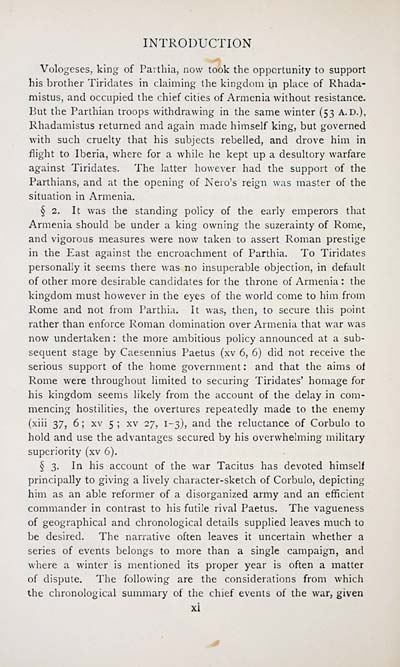Download files
Complete book:
Individual page:
Thumbnail gallery: Grid view | List view

INTRODUCTION
Vologeses, king of Parthia, now took the opportunity to support
his brother Tiridates in claiming the kingdom in place of Rhada-
mistus, and occupied the chief cities of Armenia without resistance.
But the Parthian troops withdrawing in the same winter (53 A.D.),
Rhadamistus returned and again made himself king, but governed
with such cruelty that his subjects rebelled, and drove him in
flight to Iberia, where for a while he kept up a desultory warfare
against Tiridates. The latter however had the support of the
Parthians, and at the opening of Nero's reign was master of the
situation in Armenia.
§ 2. It was the standing policy of the early emperors that
Armenia should be under a king owning the suzerainty of Rome,
and vigorous measures were now taken to assert Roman prestige
in the East against the encroachment of Parthia. To Tiridates
personally it seems there was no insuperable objection, in default
of other more desirable candidates for the throne of Armenia : the
kingdom must however in the eyes of the world come to him from
Rome and not from Parthia. It was, then, to secure this point
rather than enforce Roman domination over Armenia that war was
now undertaken : the more ambitious policy announced at a sub-
sequent stage by Caesennius Paetus (xv 6, 6) did not receive the
serious support of the home government : and that the aims of
Rome were throughout limited to securing Tiridates' homage for
his kingdom seems likely from the account of the delay in com-
mencing hostilities, the overtures repeatedly made to the enemy
(xiii 37, 6 ; XV 5 ; xv 27, 1-3), and the reluctance of Corbulo to
hold and use the advantages secured by his overwhelming military
superiority (xv 6).
§ 3. In his account of the war Tacitus has devoted himself
principally to giving a lively character-sketch of Corbulo, depicting
him as an able reformer of a disorganized army and an efficient
commander in contrast to his futile rival Paetus. The vagueness
of geographical and chronological details supplied leaves much to
be desired. The narrative often leaves it uncertain whether a
series of events belongs to more than a single campaign, and
where a winter is mentioned its proper year is often a matter
of dispute. The following are the considerations from which
the chronological summary of the chief events of the war, given
xi
Vologeses, king of Parthia, now took the opportunity to support
his brother Tiridates in claiming the kingdom in place of Rhada-
mistus, and occupied the chief cities of Armenia without resistance.
But the Parthian troops withdrawing in the same winter (53 A.D.),
Rhadamistus returned and again made himself king, but governed
with such cruelty that his subjects rebelled, and drove him in
flight to Iberia, where for a while he kept up a desultory warfare
against Tiridates. The latter however had the support of the
Parthians, and at the opening of Nero's reign was master of the
situation in Armenia.
§ 2. It was the standing policy of the early emperors that
Armenia should be under a king owning the suzerainty of Rome,
and vigorous measures were now taken to assert Roman prestige
in the East against the encroachment of Parthia. To Tiridates
personally it seems there was no insuperable objection, in default
of other more desirable candidates for the throne of Armenia : the
kingdom must however in the eyes of the world come to him from
Rome and not from Parthia. It was, then, to secure this point
rather than enforce Roman domination over Armenia that war was
now undertaken : the more ambitious policy announced at a sub-
sequent stage by Caesennius Paetus (xv 6, 6) did not receive the
serious support of the home government : and that the aims of
Rome were throughout limited to securing Tiridates' homage for
his kingdom seems likely from the account of the delay in com-
mencing hostilities, the overtures repeatedly made to the enemy
(xiii 37, 6 ; XV 5 ; xv 27, 1-3), and the reluctance of Corbulo to
hold and use the advantages secured by his overwhelming military
superiority (xv 6).
§ 3. In his account of the war Tacitus has devoted himself
principally to giving a lively character-sketch of Corbulo, depicting
him as an able reformer of a disorganized army and an efficient
commander in contrast to his futile rival Paetus. The vagueness
of geographical and chronological details supplied leaves much to
be desired. The narrative often leaves it uncertain whether a
series of events belongs to more than a single campaign, and
where a winter is mentioned its proper year is often a matter
of dispute. The following are the considerations from which
the chronological summary of the chief events of the war, given
xi
Set display mode to: Large image | Transcription
Images and transcriptions on this page, including medium image downloads, may be used under the Creative Commons Attribution 4.0 International Licence unless otherwise stated. ![]()
| Early Gaelic Book Collections > Matheson Collection > Cornelli Taciti annalium > (44) |
|---|
| Permanent URL | https://digital.nls.uk/76567439 |
|---|
| Description | Items from a collection of 170 volumes relating to Gaelic matters. Mainly philological works in the Celtic and some non-Celtic languages. Some books extensively annotated by Angus Matheson, the first Professor of Celtic at Glasgow University. |
|---|
| Description | Selected items from five 'Special and Named Printed Collections'. Includes books in Gaelic and other Celtic languages, works about the Gaels, their languages, literature, culture and history. |
|---|

